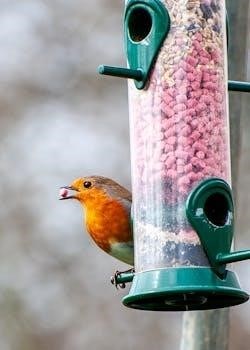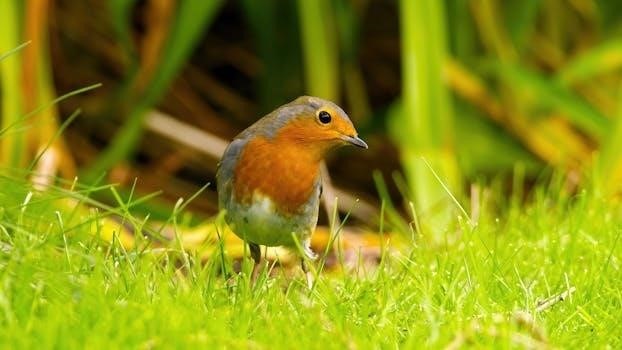Backyard birdsong offers a delightful connection with nature, transforming our daily lives with vibrant melodies. Learning to identify these songs enriches our understanding of the local ecosystem. This guide will help you get acquainted with common bird sounds, fostering appreciation and deeper engagement with backyard biodiversity.
Why Learn Backyard Birdsong?
Learning backyard birdsong enhances our sensory experience, transforming mundane moments into opportunities for discovery. Birdsongs are not just pleasant background noise; they’re a complex language revealing the presence and activity of various species. By recognizing different calls, we gain insight into bird behavior and social dynamics, understanding their communication and territorial claims. This knowledge fosters a deeper connection with our environment, moving beyond visual observation. Distinguishing songs helps track seasonal changes and bird migration patterns, making us more attuned to nature’s rhythms. It transforms our backyards into living classrooms, nurturing a sense of wonder and respect for wildlife. Furthermore, it can enhance our cognitive abilities by training our ears to recognize subtle differences in sounds. Learning birdsong is a rewarding pursuit, deepening our connection with the natural world and promoting a more mindful and engaging interaction with our surroundings.

Common Backyard Birds
Many fascinating bird species frequently visit our backyards, each with unique characteristics and songs. This section introduces several common birds found in North America, providing a starting point for identifying your local feathered neighbors.
American Robin
The American Robin, a familiar sight in North American backyards, is easily recognized by its rusty orange breast and gray back. These medium-sized birds are often seen hopping across lawns, foraging for worms and insects. Their song is a rich, throaty series of notes, a common soundtrack in many neighborhoods. Robins are widespread and adaptable, thriving in various habitats from urban parks to forests. While some migrate south for the winter, others remain, joining large roaming flocks in search of berries. Their presence is a welcome sign of spring, as they disband and spread across their full range to breed. Listen for their calls, which are often a mix of chirps and repeated phrases, a constant and comforting sound in our outdoor spaces. They are a great bird to learn to identify due to their common nature and distinctive song.
Northern Cardinal
The Northern Cardinal, with its vibrant crimson plumage in males, is one of the most recognizable backyard birds. Females, though less showy, possess a beautiful soft tawny hue. These birds are often seen in pairs, frequenting feeders and mixed habitats across the eastern and parts of the southwestern United States. Their song is a clear, whistling melody, often described as a series of “cheer” calls, making them a delightful presence in any backyard. Known as the “redbird” by many, the male cardinal’s bright color makes them easy to spot. They are very popular, acting as the state bird for seven states and the mascot of many sports teams. Listen for their distinctive song, a beautiful and easily identifiable part of backyard birdsong. Cardinals are a cherished species, and learning to recognize them is a great step.
Blue Jay
The Blue Jay, a striking bird found year-round in the eastern United States, is known for its distinctive blue, black, and white plumage and its often boisterous calls. Easily identified by its crest and bright coloring, the Blue Jay is a common sight in forests and suburban habitats. While sometimes seen as a feeder bully, their beauty and intelligence make them fascinating to observe. Their calls are varied, ranging from loud, harsh cries to soft, melodic warbles, making them a significant contributor to backyard birdsong. The vibrant blue color is due to microscopic keratin particles that scatter light, a truly impressive natural phenomenon. They are not often mistaken for another bird. Blue Jays are one of the loudest jays, and they can be heard from afar. Learning to recognize their calls is a great step in bird identification.
Mourning Dove
The Mourning Dove, a widespread and graceful bird, is easily recognized by its soft brown-gray coloring, dark spots on the wings, and long, pointed tail. They are often found in open habitats, from woodlands to cities, and are known for their gentle nature and distinctive, mournful cooing. These doves are ground feeders and are easily startled, but they can also be seen perching on wires or branches. Their calls are often mistaken for the hoots of an owl, highlighting the importance of learning to differentiate between sounds. The Mourning Dove is the most widespread dove in North America. They are easily startled ground feeders and are found in open habitats. The bird has a light-blue eye ring. A unique aspect of Mourning Doves is their production of “pigeon milk,” a nutritious substance fed to their young, adding to their intriguing nature.
American Crow
The American Crow, a large, all-black bird, is a common sight in various semi-open habitats. It can be distinguished from other similar birds by its harsh “caw!” call, which is a key identifying feature. These intelligent creatures are members of the corvid family, which includes other smart birds such as ravens and jays. Crows are known for their problem-solving skills and tool use. They have a varied diet and are often seen foraging in open areas. American Crows are found in both rural and urban settings. They are highly adaptable and curious. Distinguishing the American Crow from the Fish Crow and Northwestern Crow requires careful attention to their calls and can be useful. Their social nature and adaptability make them fascinating subjects for bird watchers.

Bird Identification Techniques
Identifying birds involves using visual cues, such as size, color, and markings. Listening to bird calls is crucial; each species has unique vocalizations. Combining these techniques enhances your ability to recognize backyard birds accurately and appreciate their diversity.

Using Visual Cues
Identifying birds through visual cues is a fundamental skill for any backyard birder. Start by observing the overall size and shape of the bird; is it small like a sparrow or large like a crow? Notice its posture and how it moves. Is it hopping, walking, or flying with a distinctive pattern? Next, focus on the bird’s plumage. Note the dominant colors, any patterns like stripes, spots, or bars, and the presence of crests or other unique features. Pay attention to the bill’s shape and size, as this can be a key identifier; a thick, cone-shaped bill indicates a seed-eater, while a thin, pointed bill suggests an insectivore. Also, look closely at the tail length and shape. Does it have a long, pointed tail like a Mourning Dove or a short, square tail? These visual details, when carefully observed, will significantly aid in identifying different bird species visiting your backyard. Remember to consider the context of the bird’s habitat and behavior to further refine your identification. By combining these visual clues, you can accurately identify the birds you see around you.
Listening to Bird Calls
Beyond visual identification, mastering the skill of recognizing bird calls is crucial for a complete backyard birdsong experience. Each species has a unique repertoire of vocalizations, ranging from complex songs to simple calls. Start by focusing on the rhythm, pitch, and tone of the sounds. Is it a melodious warble, a sharp chirp, or a soft coo? Pay attention to the speed and repetition of the notes. Some birds have distinctive patterns that repeat, while others have a more random sequence. Try to categorize the sounds into broad categories like songs, calls, alarm notes, or contact calls. Listen for variations within a single bird’s vocalization; some species can mimic the calls of others, like the Northern Mockingbird. Online resources and bird identification apps can be invaluable tools to compare the sounds you hear with recorded samples. Practice is key. Over time, your ears will become more attuned to the subtle differences, allowing you to identify the birds even when they are hidden from view. Remember that understanding bird sounds adds a whole new dimension to your appreciation of backyard nature.

Attracting Birds to Your Backyard
Creating a bird-friendly backyard involves providing food, water, and shelter. Strategic feeding and habitat creation can draw in a diverse range of species. Learn how to make your space a welcoming haven for feathered friends.
Feeding Strategies
Attracting birds through feeding requires understanding their dietary needs and preferences. Offering a variety of foods will draw a greater diversity of species to your backyard. Sunflower seeds are a popular choice, appealing to many birds like cardinals, finches, and chickadees. Nyjer seeds, also known as thistle seeds, are particularly attractive to goldfinches and other small finches. Suet, a high-energy food, is excellent for insect-eating birds, especially during colder months. Fruit, such as berries and pieces of apples, can be offered to attract robins, mockingbirds, and other fruit-loving species. Ensure that you clean your feeders regularly to prevent the spread of disease. Consider using different types of feeders to accommodate different species and prevent larger birds from monopolizing the resources. Ground feeding can also attract species like mourning doves and sparrows. It’s important to note that providing consistent food sources will create a more reliable environment for your backyard birds.
Creating Bird-Friendly Habitats
Transforming your backyard into a bird-friendly haven involves more than just providing food; it’s about creating a diverse and suitable environment. Native plants are crucial, offering natural food sources like berries, seeds, and nectar, as well as providing essential cover and nesting sites. Trees and shrubs of varying heights create different layers of habitat, attracting a wider array of bird species. Water is also vital; a bird bath or small pond can be a magnet for birds, especially during dry periods. Avoid using pesticides, as they can harm birds and their food sources. Provide nesting materials like twigs, grasses, and pet hair to aid in nest building. Leave leaf litter in some areas, as it provides habitat for insects, which are a food source for many birds. Consider adding birdhouses to encourage nesting. By implementing these strategies, you’ll create a thriving ecosystem that benefits both the birds and your enjoyment of them.
